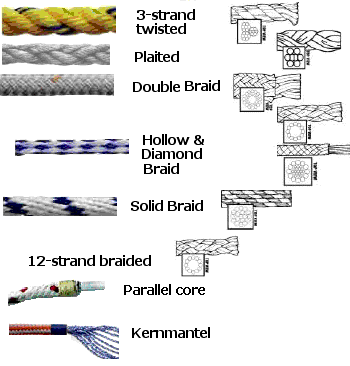 Products
Products
Don's Home
 Products
Products
| Contact |
Types of Ropes: Twisted 3-strand Plaited 8-strand Braided (12-strand, 16-strand) Diamond braid with a core (single and double braid) Diamond braid without core (hollow braid) Solid braid 12-Strand Single-Braids Parallel Core Kernmantle (Climbing) |
 Source: Wellington Commercial Cordage | |||||||||||||||||||||||||||||||||||||||||||||||||||||||||||||||||||||||||||||||||||||||||||||||
|
Rope strength can be measured in several ways: The Cordage Institute specifies that the Safe Working Load (SWL) of a rope shall be determined by dividing the Minimum Tensile Strength by the Safety Factor. Safety factors range from 5 to 12 for non-critical uses, 15 for life lines.
It was replaced by Working Load Limit (WLL) which is the actual load the piece is designed to carry as rated by the manufacturer. However, while the definition for working load limit was originally confined exclusively to the manufacturer's specified maximum load that the item could lift, it is now generally extended to include both of the following:
When you tie a knot in your rope you are lowering the Working Load Limit by about 50%.
Avoid Shock Loads.
Fibers:
Industrial grade: Polypropylene, polyethylene, nylon, polyester, combinations of polyester and polypropylene. high performance grade: Aramid: Kevlar®, Twaron®, Technora®; Ultra high molecular weight polyethylene (UHMWPE): Spectra®, high molecular weight polyethylene (HMWPE) and DSM High Performance Fibers (Dynema): Certran; Liquid crystal polymer (LCP): Vectran®; Very High Tenacity (VHT) Polyester; Polyolefin co extrusion: Polysteel®; Pet/olefin extrusion: Karat®.
Tensile Strength for 3-Strand Rope
1/2" braid of polyester over polyolefin core - 7,700 lbs. 5/8" Nylon 3-strand - 8,910 5/8" 3-STRAND PRO-SET™ NYLON 11,100 lbs 5/8" Polyester Double Braid - 13,500 5/8" Nylon Double Braid - 15,000 Ultra high molecular weight polyethylene fiber (UHMWPF) - 5/16 - rated for a minimum of 12,330 lbs., 3/8 - 18,400, 5/8 - 54,600. Used for winch lines.
Climbing Ropes:
Dynamic - lead climbing - Strong and elastic enough to absorb the impact of a fall and offer limited stretch. Usuallly 11-11.5 mm = 7/16 in Sizes: 5/16 in = 8-9 mm, 3/8 in = 9.5-10 mm, 7/16 in. = 11-11.5 mm 8 mm. 3,500 Lbs 11 mm. dynamic climbing rope - 11 mm. static climbing rope - 6,600 lbs (3,000 kg) (dynamic rope is measured in falling weight (10 mm. = 175 lbs. and kN) 50 mm. (2 ") webbing - 5,900 lbs. 25 mm. (1 ") webbing - 4,500 lbs. 2" recovery strap nylon- 14,000 lbs. 5/8" 3-strand twisted poly rope- (Home Depot) 700 lbs. 5/8 3-strand poly tow rope - New England Ropes Polytester 6,800 lbs. JustRopes.com - Choosing your Cord | ||||||||||||||||||||||||||||||||||||||||||||||||||||||||||||||||||||||||||||||||||||||||||||||||
| 1. Stretch at 25% of Tensile Strength
|
Climing Rope Stretch Note: Energy absorption for a climbing rope is the product of strength and elongation, or the area under the force vs elongation curve above. It is also better to have less stretch at low loads to facilitate taking tension, pendulums, prussiks, and rappels. | |||||||||||||||||||||||||||||||||||||||||||||||||||||||||||||||||||||||||||||||||||||||||||||||
|
The strength of a rope is measured by the rating of static elongation and maximum impact force. The maximum impact force allowed by the UIAA is 2,680 pounds (12 kilonewtons kN) and is determined in its drop test. 12 kN is the force a human body can take before things break; organs rupture, bones break. The test fall involves dropping a 176-pound (80 kg) load 16.5 feet on 8.25 feet of rope with the rope running over an edge that simulates a carabiner. Maximum impact force refers to the amount of force transmitted to a climber during a fall. Low maximum impact force means the rope (not the climber or the protection) absorbs more of the energy generated in a fall. However, such ropes stretch more, increasing your chances of hitting the ground or a ledge. Climbing ropes are also rated by the number of falls they can take before being retired. Rope Falls kN 10.1-11mm 10-17 UIAA falls 8-9.5 for rope and 9.5-10 mm 7-9 UIAA falls 8.5-9 mm 5 Polypropylene has excellent resistance to most acids and alkalis, except chlorosulphonic, concentrated sulfuric acids and chlorinated hydrocarbons at 160o F. All withstand most diluted bleaching solutions. SUNLIGHT/UV: Polyester and Nylon both have very little degradation from UV. Polypropylene is susceptible to UV degradation and should be inspected regularly if used outside over a long term. mendation can be made because it depends on the application and conditions of use, especially potential danger to personnel. It is recommended that the user establish working loads and safety factors based on professional and experienced assessments of risks. The working load is a guideline for the use of a rope in good condition for non-critical applications and should be reduced where life, limb, or valuable property is involved, or exceptional service such as shock, sustained loading, severe vibration,
Cable:
Arborist Equipment:
New Tribe Tree Climbing Gear - Tree Climbing Course, Tips, Equipment Links: Guide to Rope Engineering, Design, and Use at Sterling Rope Wellington Commercial Cordage New England Ropes Climbing Rope Buying Guide - How to Buy Climbing Ropes How to Choose a Climbing Rope: Expert Advice from REI
| ||||||||||||||||||||||||||||||||||||||||||||||||||||||||||||||||||||||||||||||||||||||||||||||||